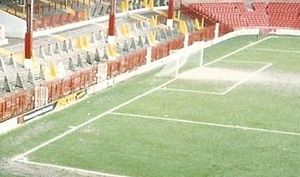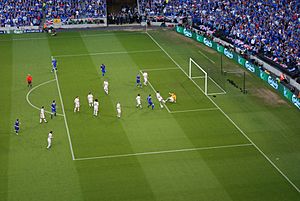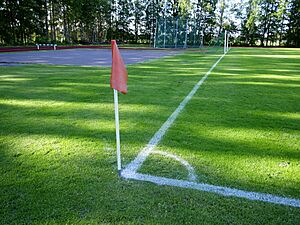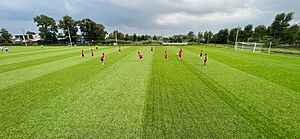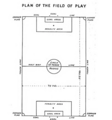Football pitch facts for kids
A football pitch or soccer field is the special playing area for the game of association football. Its size and markings are set by Law 1 of the Laws of the Game, which are the rules of football. The pitch is usually made of natural grass or artificial turf. However, some amateur teams might play on dirt fields. Artificial surfaces must always be green.
All the lines on the pitch are part of the area they define. For example, if a ball is on the touchline, it's still in play. A foul committed over the line of the penalty area means a penalty kick. For a goal to count, the ball must completely cross the goal line between the goal posts. If any part of the ball is still on or above the line, it's not a goal, and the game continues.
The rules for adult matches are explained below. The first measurements for football fields were in imperial units (like yards and feet) because British football associations helped create the game. Since 1999, the rules prefer metric units (like meters), but imperial units are still often used, especially in the United Kingdom.
Contents
Understanding the Pitch Boundaries
A football pitch is shaped like a rectangle. The shorter sides are called goal lines, and the longer sides are called touchlines. Both goal lines must be the same length, between 50 and 100 yards (about 45 to 90 meters) wide. Both touchlines must also be the same length, between 100 and 130 yards (about 90 to 120 meters) long.
All the lines on the ground must be the same width, no more than 12 centimeters (about 5 inches) wide. Special flags mark the corners of the pitch.
For international matches, the field sizes are stricter. Goal lines are usually between 70 and 80 yards (about 64 to 73 meters) wide. Touchlines are between 110 and 120 yards (about 100 to 110 meters) long. FIFA, the world football governing body, suggests a pitch should be exactly 105 meters (about 115 yards) long and 68 meters (about 74 yards) wide. Most top professional pitches follow these recommendations.
The term goal line refers to the entire line at each end of the pitch, from one corner flag to the other. Sometimes, people use the word byline to talk about the part of the goal line that is outside the goalposts.
Football Goals and How They Work
Goals are placed in the middle of each goal line. Each goal has two upright posts that are the same distance from the corner flags. A horizontal bar, called a crossbar, connects the top of these posts. The inside edges of the posts are 8 yards (about 7.32 meters) apart. The bottom edge of the crossbar is 8 feet (about 2.44 meters) above the ground. This means the area players shoot at is about 192 square feet (about 17.8 square meters). Nets are usually placed behind the goal, but the rules don't say they have to be there.
Goalposts and crossbars must be white. They can be made of wood, metal, or other approved materials. The rules allow for some flexibility in their shape, but they must be safe for players. Modern materials are used to make goalposts safer, reducing the impact if a player accidentally runs into them.
A goal is scored when the ball completely crosses the goal line between the goalposts and under the crossbar. This counts even if a defending player touched the ball last before it went in. However, a referee can decide a goal is not valid if a player on the scoring team breaks a rule before the goal is scored. This also applies if an opposing player commits a foul before the ball crosses the line, leading to a penalty that might not have been taken yet.
For junior matches, the football goals are usually about half the size of adult goals.
Special Areas: Penalty and Goal Boxes
There are two rectangular boxes marked on the pitch in front of each goal.
The goal area is often called the "six-yard box". It's a rectangle formed by the goal line, two lines that start 6 yards (about 5.5 meters) from each goalpost and go 6 yards into the pitch, and a line connecting those two lines. This box is 6 yards by 20 yards (about 5.5 meters by 18.3 meters). Goal kicks and any free kicks for the defending team can be taken from anywhere inside this area.
The penalty area is often called the "18-yard box" or just "the box". It's a larger rectangle formed similarly. Its lines start 18 yards (about 16.5 meters) from each goalpost and extend 18 yards into the field. This box is 44 yards by 18 yards (about 40.2 meters by 16.5 meters). This area is important for several reasons:
- It's where the goalkeeper is allowed to handle the ball with their hands.
- If a defender commits a foul inside this area that would normally be a direct free kick, it results in a penalty kick instead.
The penalty mark is often called the "penalty spot" or "the spot". It's a small mark 12 yards (about 11 meters) directly in front of the center of the goal. This is where penalty kicks are taken from.
The penalty arc is a curved line outside the penalty area, 10 yards (about 9.15 meters) from the penalty mark. During a penalty kick, all players except the kicker and the defending goalkeeper must stay outside this arc and the penalty area.
Other Important Markings on the Pitch
The centre circle is marked 10 yards (about 9.15 meters) from the centre mark. The centre mark is exactly in the middle of the pitch. Like the penalty arc, the centre circle shows how far away opposing players must stay during the kick-off. The ball is placed on the centre mark for kick-off. During penalty shootouts, all players except the two goalkeepers and the current kicker must stay inside this circle.
The half-way line divides the pitch into two equal halves. The half a team defends is called their half. Players must be in their own half at kick-off. A player cannot be called offside if they are in their own half. Flags can optionally mark where the half-way line meets the touchlines.
The small arcs in the corners show the area (within 1 yard or about 0.9 meters of the corner) where the ball must be placed for corner kicks. Opposing players must stay 10 yards (about 9.15 meters) away during a corner kick. Sometimes, there are optional lines off the pitch, 10 yards away from the corner arc, to help measure this distance.
The Playing Surface: Grass or Artificial Turf
Natural grass is the usual playing surface for football. However, artificial turf is sometimes used, especially in places where it's hard to keep grass healthy. This can be in very wet areas where grass wears out quickly, or very dry areas where grass dies. Artificial turf is also common in colder countries, like the Nordic countries, because of heavy snow in winter. The latest artificial surfaces use tiny rubber pieces, called rubber crumbs, instead of sand.
Some leagues and football associations prefer grass pitches because of concerns about injuries on artificial surfaces. All artificial turf must be green and meet specific quality standards set by FIFA.
Football can also be played on dirt or gravel fields. In most parts of the world, dirt fields are only used for casual, fun games.
A Look Back: History of the Football Pitch
Before the International Football Association Board (IFAB) set the exact sizes, early football rules stated pitches could be between 50 and 100 yards (about 45 to 90 meters) wide and 100 to 200 yards (about 90 to 180 meters) long.
Football goals were first mentioned in England in the late 1500s and early 1600s. Writers like John Norden and Richard Carew described "goals" in a game called Cornish hurling. Carew explained that goals were made by placing "two bushes in the ground, some eight or ten foote asunder." The idea of scoring a goal appeared in a play around 1600.
Solid crossbars for goals were first introduced by the Sheffield Rules of football. Football nets were invented by a Liverpool engineer named John Brodie in 1891. Nets were very helpful because they made it much clearer whether a goal had been scored or not.
Images for kids
See also
- Football field (for other sports called "football")
- Turf management
- Groundskeeping



